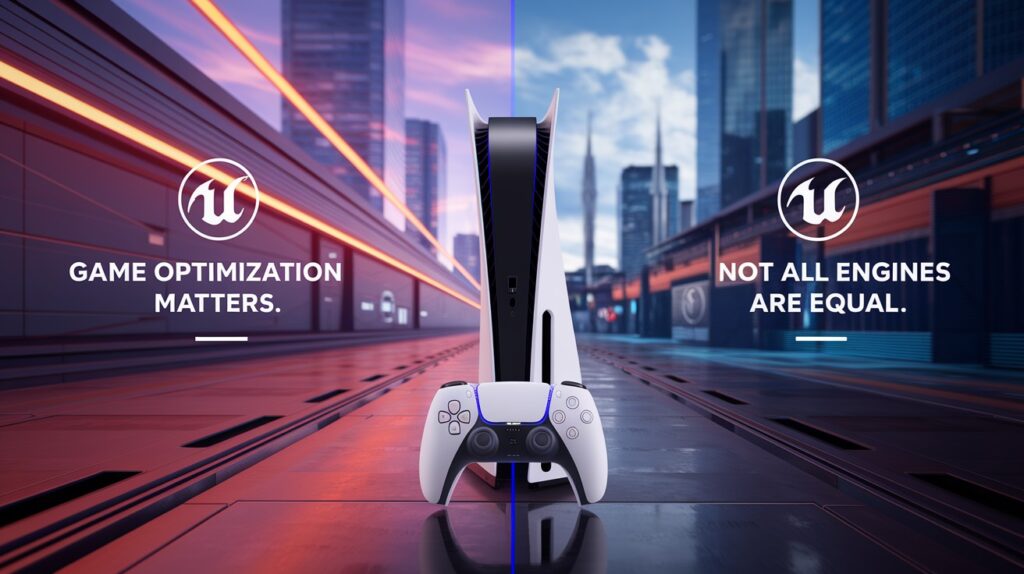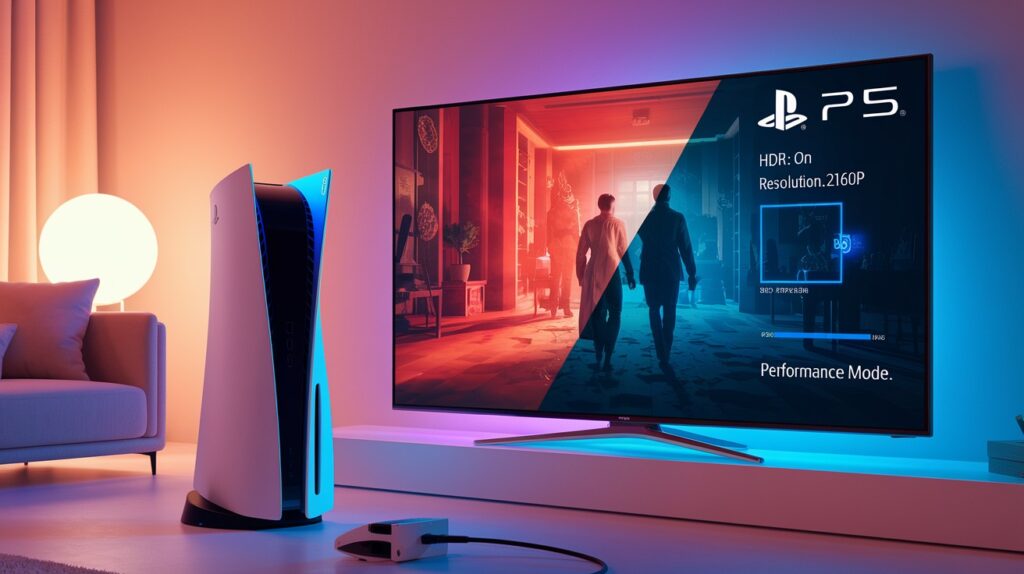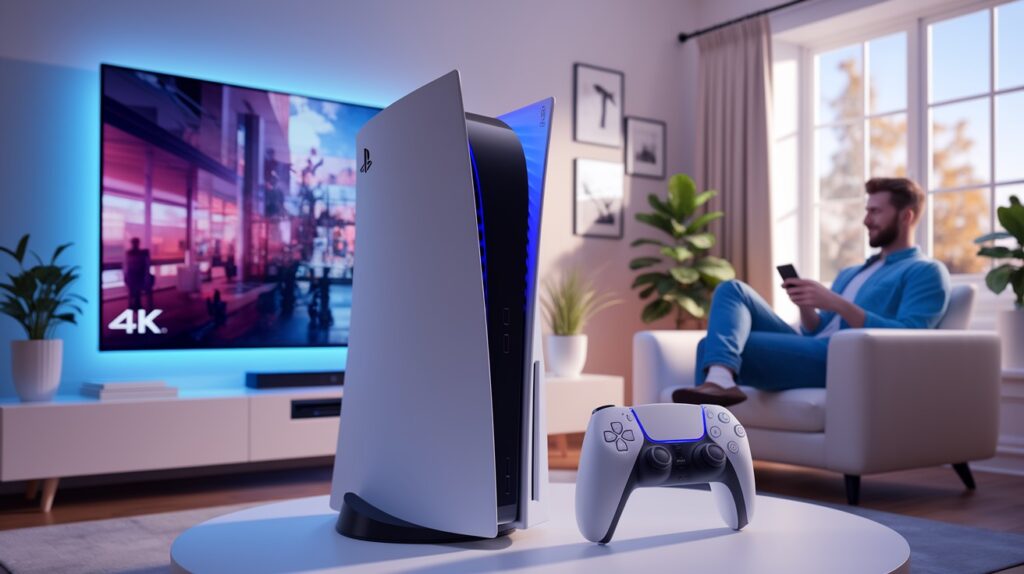Got a PS5 and wondering if it’s 4K? You’re not alone. This question pops up everywhere online, and the answers can be confusing.
Here’s the thing: the PS5 situation with 4K isn’t as simple as a yes or no answer. Some games run in true 4K. Others don’t. Many use tricks to get close to 4K quality.
In this article, we’ll clear up the confusion. We’ll explain what 4K means for gaming, which PS5 games run in real 4K, how upscaling and other techniques work, and what to expect from your console.
I’ve tested dozens of PS5 games and researched the technical specs. No marketing fluff here – just straight facts about what your console can and can’t do.
By the end, you’ll know exactly what to expect from PS5 graphics. No more guessing or wondering if you’re getting the full experience. Let’s get into the real story behind PS5’s 4K capabilities.
What Does “4K Gaming” Really Mean?

Let me break this down for you in simple terms. 4K gaming gets thrown around a lot, but what does it actually mean?
Defining 4K Resolution
Native 4K means one thing: 3840 x 2160 pixels. That’s 8.3 million pixels packed into your screen.
Here’s how it compares to other resolutions:
- 1080p: 1920 x 1080 (2.1 million pixels)
- 1440p: 2560 x 1440 (3.7 million pixels)
- 4K: 3840 x 2160 (8.3 million pixels)
Why does pixel count matter? More pixels mean sharper images. You see more detail. The text looks cleaner. But here’s the catch – your console has to power all those pixels.
That takes serious processing muscle.
4K Gaming vs. 4K Media Playback
Watching a 4K movie is easy. The video file is already made. Your PS5 just displays it.
Gaming in 4K is different. Your console creates every frame from scratch. In real-time. While you’re playing.
Think about it this way: watching 4K is like looking at a photo. Gaming in 4K is like painting a masterpiece 60 times per second.
PS5’s Official 4K Specifications and Hardware
Sony’s Official Marketing Claims
Sony says the PS5 can handle “up to 4K 120Hz.” That sounds impressive. But what’s under the hood?
The specs look solid on paper:
- RDNA 2 GPU: 10.28 teraflops of power
- Custom AMD Zen 2 CPU: Running at 3.5GHz
- Variable frequency: The GPU can boost when needed
Here’s what Sony doesn’t tell you upfront – that “up to” part is key.
Hardware Architecture Supporting 4K
The PS5 packs some serious hardware for 4K gaming:
Memory and bandwidth:
- 16GB GDDR6 RAM for fast data access
- 448GB/s bandwidth to move information quickly
Display output:
- HDMI 2.1 support handles true 4K at high refresh rates
- Can push 4K at 60fps or 120fps (when games support it)
But here’s the reality check – having the hardware and using it are two different things. The real question is: how do games perform?
The Reality of PS5 4K Performance
Native 4K vs. Upscaled 4K
Here’s where things get interesting. Not all “4K” on PS5 is 4 K.
True native 4K games render every pixel at full resolution. These include:
- Spider-Man: Miles Morales (in Fidelity mode)
- Ghost of Tsushima Director’s Cut
- The Last of Us Part II (PS5 version)
But many games use tricks instead. They render at lower resolutions, then scale up to 4 KK.
Checkerboard rendering is popular. Think of it like a chessboard pattern. The game renders half the pixels, then fills in the blanks using smart guessing. Your eye can’t tell the difference most of the time.
Temporal upscaling uses previous frames to help build the current one. It’s like using yesterday’s homework to help with today’s.
Dynamic resolution scaling changes resolution on the fly. Busy scenes drop to 1800p or 1440p. Quiet moments bump back up to 4 K. You rarely notice it happening.
Frame Rate Trade-offs
Here’s the big choice you’ll face with most PS5 games: quality or speed.
4K at 30fps gives you the sharpest image. Everything looks crisp. But movement feels sluggish. Especially in fast games.
4K at 60fps is smoother but harder to achieve. Only the most optimized games pull this off.
Most games offer two modes:
- Performance Mode: Usually 1440p-1800p at 60fps
- Quality Mode: 4K or near-4K at 30fps
Ray tracing makes everything harder. Those realistic reflections and lighting eat up processing power like crazy. Turn on ray tracing? Expect lower resolution or frame rates.
I recommend Performance Mode for most games. Smooth gameplay beats pixel counting.
Game-by-Game Analysis
Sony’s first-party games perform best. They’re built specifically for PS5 hardware.
Top native 4K performers:
- Demon’s Souls: Stunning visuals at 4K/30fps
- Ratchet & Clank: Rift Apart: 4K with ray tracing
- Horizon Forbidden West: True 4K in Quality mode
Third-party games tell a different story. Developers target multiple consoles. They can’t optimize for PS5 alone.
Common compromises in third-party titles:
- Call of Duty: Dynamic 4K (1800p-2160p range)
- Cyberpunk 2077: 1440p upscaled to 4K
- Assassin’s Creed Valhalla: 1728p reconstructed to 4K
Cross-platform games often struggle most. Xbox Series X sometimes gets a slightly better resolution. PC versions usually offer more options.
The bottom line? Your PS5 can do 4 K., but not always. And not in every game.
Factors Affecting PS5’s 4K Performance
-
Game Optimization and Engine Differences

Not all game engines are created equal. Some handle 4K better than others.
Unreal Engine 5 performs well on PS5. Games like Fortnite and The Matrix Awakens show what’s possible. But older engines struggle.
Developer priorities matter more than you think. Some studios focus on 4K visuals. Others prioritize frame rates or special effects. There’s always a trade-off.
Launch titles often underperform. Developers didn’t have time to optimize fully. Compare Spider-Man: Miles Morales at launch to games released two years later. The difference is huge.
Later games squeeze more performance from the same hardware. It’s like learning to drive a car better over time.
-
Graphics Settings and Visual Features

Ray tracing kills 4K performance. Those realistic reflections come at a cost.
Here’s the brutal truth: Most games can’t do both ray tracing and 4K at 60fps. You have to pick one.
HDR adds another layer of complexity. High Dynamic Range makes colors pop. But it requires extra processing power. Some games handle it better than others.
Variable Rate Shading helps save performance. It reduces detail in areas you won’t notice. Like the corners of your screen during fast action. Smart developers use this trick well.
Maximizing Your PS5’s 4K Experience

Optimal Display Settings
Your PS5 settings matter. Go to Settings > Screen and Video > Video Output.
Key settings to check:
- Resolution: Set to Automatic or 2160p
- HDR: On (if your TV supports it)
- Deep Color Output: Automatic
Your TV or monitor needs HDMI 2.1 for the best experience. HDMI 2.0 works, but limits you to 4K at 60fps max.
Not all 4K TVs are equal. Check your TV’s specs. Some older 4K TVs can’t handle gaming properly.
When to Choose 4K vs. Performance Modes
Single-player games? Quality mode often works well. You can enjoy the visuals without worrying about competitive advantage.
Multiplayer games are different. Frame rate wins over resolution. That extra smoothness helps your aim and reaction time.
Genre-specific tips:
- Racing games: Performance mode for smooth motion
- RPGs: Quality mode for detailed environments
- Shooters: Always choose Performance mode
- Puzzle games: Quality mode is fine
Trust your eyes, not the specs. If it looks good to you, that’s what matters.
Common Misconceptions About PS5 4K Gaming
“All Games Run at 4K” Myth
This is the biggest lie in gaming marketing. Most PS5 games don’t run at native 4 K.
The reality check:
- About 30% of games hit native 4K consistently
- 50% use upscaling techniques to reach 4K
- 20% don’t even try – they focus on other features
Marketing language tricks you. “4K support” doesn’t mean “4K gameplay.” “Up to 4K” means it might hit 4K sometimes. Maybe.
“4K Always Looks Better” Assumption
Here’s something most people don’t know: 4K doesn’t always look better.
Your viewing distance matters. Sitting 8 feet from a 55-inch TV? You might not see the difference between 4K and 1440p.
Frame rate often matters more. Smooth 60fps at 1440p beats choppy 30fps at 4 KK. Your brain notices smooth motion more than extra pixels.
Screen size is key too. On a 27-inch monitor, 1440p looks almost identical to 4 K. Save your processing power for other things.
The Final Verdict: Is PS5 Truly 4K?

Technical Answer
The PS5 has 4K capability. The hardware can output true 4K resolution. But capability and reality are different things.
Native 4K gaming happens in some games. Upscaled 4K happens in many others. Neither happens in quite a few games.
It’s like owning a sports car. Yes, it can go 200mph. But you won’t drive that fast to the grocery store.
Practical Answer for Gamers
What should you expect? A mix of experiences.
Sony’s first-party games usually look amazing. They hit 4K or get very close. Third-party games arehit or misss.
Your PS5 will give you great visuals. Sometimes that’s true 4K. Sometimes it’s clever upscaling. Most of the time, you won’t care which one it is.
The real question isn’t “Is it 4K?” The real question is “Does it look good?” And yes, PS5 games look fantastic.
Bottom line: Your PS5 can do 4K. Just don’t expect it in every game, every time.
Conclusion
So, is PS5 4K or not? The answer is both yes and no. Your PS5 can absolutely do 4K gaming – but it depends on the game.
Some titles hit native 4K beautifully. Others use smart upscaling tricks. Both can look great on your screen.
Don’t get caught up in pixel counting. Focus on what matters: does the game look good and play smoothly? Most PS5 games deliver excellent visuals, whether they’re true 4K or not.
Your PS5 gives you fantastic gaming experiences. That’s what counts. The 4K debate is just technical noise.
Frequently Asked Questions
Does PS5 run games in true 4K resolution?
Some games run native 4K, but many use upscaling techniques like checkerboard rendering to achieve 4 K-like quality with better performance.
Can PS5 do 4K at 120fps for all games?
No, very few games support 4K at 120fps. Most 4K games run at 30- 60fps, with 120fps typically available at lower resolutions.
Do I need a 4K TV to benefit from PS5?
No, PS5 offers improvements on 1080p displays, including better frame rates, faster loading, ray tracing, and enhanced backward compatibility features.
Is PS5’s 4K better than Xbox Series X?
Xbox Series X has slightly more powerful hardware, but most games have minimal real-world 4K performance differences between consoles.
Why do some PS5 games look blurry in 4K mode?
Games using aggressive upscaling, dynamic resolution scaling, or temporal reconstruction techniques can appear softer than native 4K rendering.







